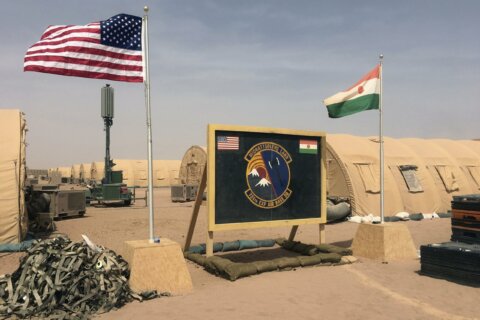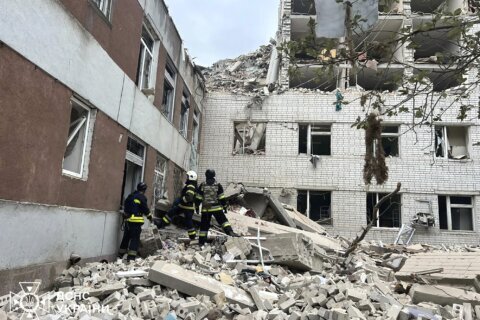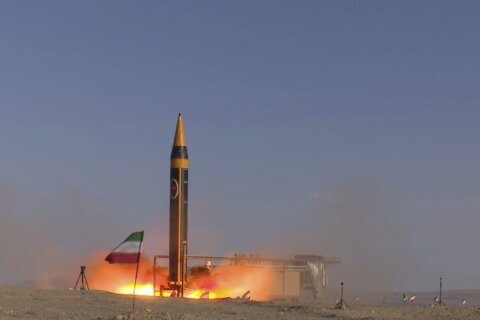In the fall of 2021, Russian troops began assembling near its border with Ukraine, ostensibly planning military exercises with Belarus. Talk of an invasion of Ukraine grew.
At the time, WTOP national security correspondent J.J. Green began daily contact with sources in Ukraine and traveled to the Baltics, as well as Western Europe. Since then, he has conducted more than 200 interviews with government, intelligence and military officials from more than a dozen countries, including in Ukraine, the United States, the Baltic nations and Western Europe.
The objective of this report is to paint a picture of a conflict that rapidly unfolded before the world’s eyes and continues to chronicle its progression today. This series of reports will continue in 2023.
Prelude to war
One hundred years ago, in 1922, the Soviet Union materialized. In 1946, following World War II, its seemingly impenetrable Iron Curtain officially descended on Europe and parts of Asia, strangling free speech. Democracy was outlawed, and self-determination was largely prohibited.
The global domination dream of Joseph Stalin, the architect of Communism, thrived until sweeping political and economic changes were established in 1985 by General Secretary Mikhail Gorbachev, who died in August.
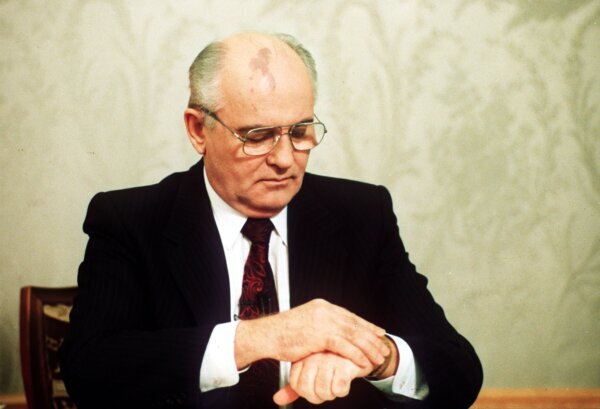
Six years later, the massive empire stretching from East Asia to Western Europe collapsed. At its peak, between 1946 and 1991, the USSR spanned around 8.6 million square miles, seven times the size of India and more than two times the area of the United States.
Since losing the Cold War and disintegrating in 1991, tiny sparks of lingering aggression have glowed among the dismembered ideological ruins of the former USSR, threatening to reconstitute as a modern, global powerhouse.
Hidden deep under the political debris left by the collapse, these conditions spread out, and secret flashes of ambition flickered, seeking a source of fuel that would ignite and consolidate the embers, returning a reunified Soviet Union to the pinnacle of global power.
One man, willingly, driven by his own bottomless desire to reconstruct the Soviet Union, sought out and eventually found those sparks, catalyzing the effort. In August 2008, during a brief war with Georgia, Vladimir Putin put the world on notice that the return of the Iron Curtain was possible.

In July of 2014, a second warning came as Russia invaded Ukraine. The world did little to help.
In early 2022, the Kremlin believed the time had come. All pretenses and facades were dropped. Moscow launched its renewed quest to reconstitute the USSR, starting with Ukraine. The plan would be to occupy the entire country, decapitate the leadership and officially declare the USSR was back.
Zero hour arrives
Time and time again, the world had been warned Russia was going to attack Ukraine. Time and time again, the world ignored it. But on Feb. 24, 2022, at 3:25 a.m. in Ukraine, time had run out.
Air raid sirens blared across Ukraine and missiles rained down on Europe’s second-largest country. Millions of people streamed across its western borders seeking shelter in neighboring Poland, Romania, Slovakia and Moldova. The world was watching something that most people never believed would happen again after World War II — the full-scale invasion of a European country.
At 5:30 a.m. Moscow time, state television channels began broadcasting an address by Putin. He blamed NATO for aiding the military expansion of Ukraine, saying it was “unacceptable,” and that he termed a “special military operation” was underway.
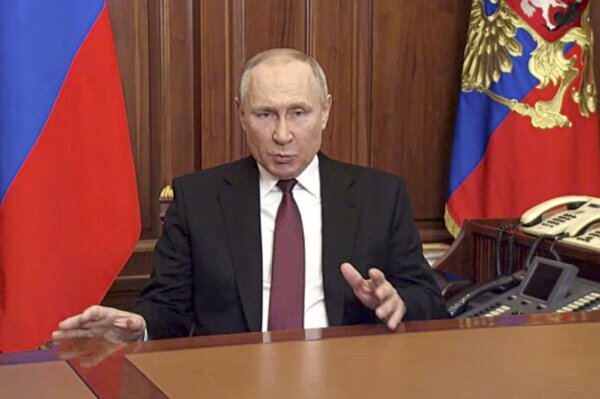
The U.S. and its NATO allies quickly took notice after having warned for weeks that a large-scale invasion was coming.
At 1:43 p.m. eastern time, during a hastily-arranged White House address to the nation, President Joe Biden said, “The Russian military has begun a brutal assault on the people of Ukraine without provocation and without justification. This is a premeditated attack … Vladimir Putin has been planning this for months.”
Putin, Biden said, had amassed more than 175,000 troops, military equipment and field hospitals, complete with large supplies of blood on Ukraine’s borders with Russia and Belarus.
“This tells you all you need to know about his intentions all along,” Biden said, referring to Moscow’s earlier claim that its troops staging in Belarus had merely been there temporarily as part of a training exercise.
In an impassioned 14-minute speech, Biden said, “Putin is the aggressor, Putin chose this war, and now he and his country will bear the consequences.”
Putin’s war hits a snag
On the fourth day of the invasion, Russian Lt. Gen. Yakov Rezantsev, commander of the Russian Army’s 49th combined arms division, said the war would be over in a matter of hours. But a month later, Ukraine was still fighting — and Rezantsev was dead.
He was the fifth of more than a dozen top Russian general officers to die in a conflict that went horribly wrong for Moscow. There were three main contributing factors: Corruption, poor planning, and Moscow’s drastic underestimation of Ukraine’s resolve.
In the early days of the war, it was clear Russia had expected little to no resistance from Ukrainian armed forces and civilians. That miscalculation was blamed on Russian intelligence, which had years and hundreds of millions of dollars to construct a collection apparatus inside Ukraine.
Its mission was to develop the relationships and infrastructure that would help the Russian government facilitate the Kremlin’s goal of dominating Ukraine. But two weeks later, in a stunning sequence of events, several top Russian intelligence leaders were arrested.
On March 11, Russian journalists Irina Borogan and Andrei Soldatov, both exiled and hunted by the Kremlin because of their incisive and revelatory reporting about the Kremlin’s misdeeds, broke an explosive story for the Center for European Policy Analysis.
It read:
The Fifth Service of the FSB, Russia’s main intelligence service, has been targeted and the leadership placed under house arrest, according to the authors’ sources.
Its head, Colonel-General Sergei Beseda, and his deputy were being held after allegations of misusing operational funds earmarked for subversive activities and for providing poor intelligence ahead of Russia’s now-stuttering invasion.”
They wrote, “The operation has hit serious obstacles, not least fierce resistance by the Ukrainian armed forces and the unity of the population, including most Russian-speakers, behind President Volodymyr Zelenskyy and his government.”
The resistance they spoke of was widespread and started well before the war began. In the run up to the conflict, Ukrainians had prepared to fight with anything they had.
“There will be a rifle in every window,” said Malcolm Nance, a retired U.S. Navy cryptologist who went to Ukraine to fight alongside its military. He added, “The joke here is that a Russian invasion would be an invitation to the largest Molotov cocktail party in the history of the world.”
That spirit was backed by Ukraine’s government.
“We are not afraid,” exclaimed Yevheniia Kravchuk, a member of Ukraine’s Parliament, during what became regular updates with WTOP.
Kravchuk, who has traveled the world with fellow members of parliament drumming up support for the war, said the support is not superficial: “This is the first time we have a state — that has an army, that has a leadership — that is not afraid to stand up for our country.”
A long winter settles on Ukraine
On Oct. 23, U.S. Defense Secretary Lloyd Austin, aware of the escalating urgency in the conflict between Russia and Ukraine, made a phone call to his Russian counterpart Defense Minister Sergei Shoigu. The two had not spoken since May.
“He felt that it’s important to keep the lines of communication open,” said Pentagon press secretary Gen. Pat Ryder.
Two days later, something remarkable happened.
“On Sunday, Russia’s Minister Shoigu followed up and asked to speak with Secretary Austin,” Ryder said.
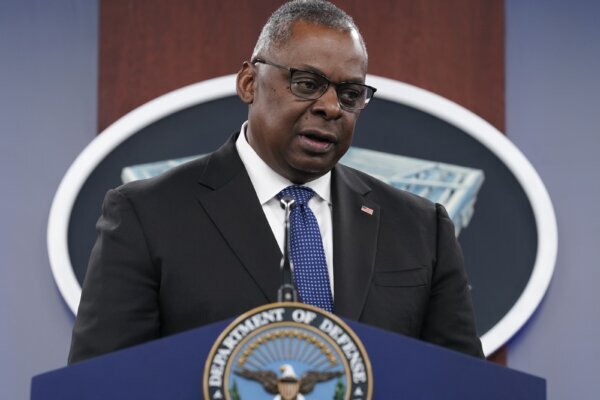
It provided the two of them the opportunity to keep the channel of communications open, as Putin and his deputies had repeatedly mentioned the use of nuclear weapons.
According to Ryder, “These kinds of calls are important in order to prevent potential miscalculation or escalation.”
This appeared to be one of many cracks in Moscow’s steely, wartime facade. The most devastating, according to Ukrainian media, is that more than 500 Russian troops are dying each day. Ukraine’s military says more than 100,000 Russian troops have died since the conflict began. Ukraine has suffered just as many deaths and injuries, according to Pentagon calculations.
Russia has also lost much of the territory it captured in the war and its troops have fled, leaving millions of dollars of equipment behind. It is now dependent upon North Korea and Iran for weapons to use. Yet, Russia continues in its war, now not far off from the one-year mark.
Swarms of drones from Iran are launched at cities across Ukraine, in addition to cruise missiles. They have two main targets: Electrical, heating and water infrastructure, as well as civilians.
Gen. Mark Milley, chairman of the U.S. Joint Chiefs of Staff, said in early November that close to 40,000 Ukrainian civilians had died after being caught up in the conflict.
At times, as much as 30% to 40% of Ukraine’s power has been out because of the strikes. Blackouts are regular occurrences to save power for hospitals and other critical functions. Children do homework by candlelight. People eat food cooked over open flames or on wood stoves.
It’s taking a steep toll on Ukrainians.
“All of us, myself and my colleagues, we’re all slightly crazy by now,” said Yuriy Sak, an adviser to Ukraine’s Minister of Defense, during weekly updates with WTOP on the war. “We’re not normal. We’ve been living in an abnormal situation. In a strange way, we’re beginning to get used to it. It’s a frightening feeling.”
But it’s a feeling that Kurt Volker, a distinguished fellow at the Center for European Policy Analysis, urges Ukraine and the world to resist and warns of what could happen.
“If Ukraine falls to Russia, Europe is over,” the former U.S. Ambassador to NATO said.
If Ukraine loses the war, “This idea that Europe is a place where all of its people can live in peace and democracy — that idea is lost.”


